Summer 2022 Quarterly Newsletter
| Statewide News | Northern California | Southern California |
High-Speed Rail Advances Through the Summer
The summer months have brought many highlights for the high-speed rail program as we continue to make progress on the cleanest and greenest infrastructure project in the state’s history.
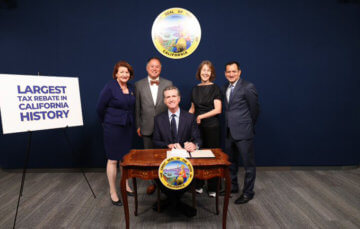 The Latest on Funding
The Latest on Funding
The Authority achieved a major milestone in June when the California Legislature appropriated the remaining $4.2 billion in Proposition 1A bond funds to support ongoing construction in the Central Valley. This action helps the Authority move forward with its commitment to making an initial operating segment between Merced to Bakersfield a reality and continues our effort to make measured investments in our bookend segments.
Earlier this month, the Authority received $25 million in federal grant funding. The grant was awarded through the Rebuilding American Infrastructure with Sustainability and Equity (RAISE) discretionary grant program, and $25 million is the maximum grant award. This is the second grant the high-speed rail program has received under the Biden Administration. The Authority is also pursuing $1.3 billion in federal grant funding to double-track the 119 miles currently under construction and purchase new, clean, electric train sets capable of speeds in excess of 200 miles per hour. This funding would also advance the next phase of design for two segments into the Bay Area (San Francisco to San José and San José to Merced) and into Southern California (Bakersfield to Palmdale and Burbank to Los Angeles), as well as help accelerate construction for electrified high-speed rail between Merced and Bakersfield by the end of the decade.
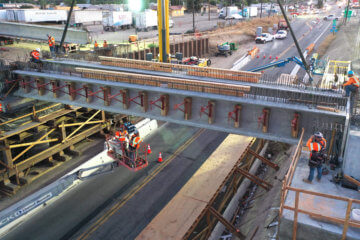 Construction Progress
Construction Progress
In the first week of July, we reached a historic construction milestone as the final pre-cast girders were placed on Construction Package 4. With this placement, all structures along the 22-mile stretch of high-speed rail between just north of the Tulare/Kern county line and Poplar Avenue south of the city of Wasco are now in construction. Through the night, construction crews placed 12 pre-cast concrete girders over the State Route 46 underpass in Wasco to create a bridge that will carry high-speed trains parallel to the BNSF railroad.
Since the start of construction, the California high-speed rail project has created more than 8,000 construction jobs, a majority of which go directly to those living in the Central Valley. There are currently 119 miles under construction in the Central Valley with more than 30 active construction sites. To check out more progress, view the Summer Construction Update video.
Statewide Updates
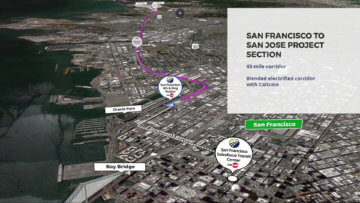 The August Board of Director’s meeting was packed with important milestones. On August 18, the Board certified the Final Environmental Impact Report/Environmental Impact Statement (Final EIR/EIS) and approved the approximately 43-mile project for the San Francisco to San José section. This action completed the environmental clearance for high-speed rail in Northern California and extends environmental clearance to 420 miles of the project’s 500-mile alignment from San Francisco to Los Angeles/Anaheim. Read more about this significant milestone.
The August Board of Director’s meeting was packed with important milestones. On August 18, the Board certified the Final Environmental Impact Report/Environmental Impact Statement (Final EIR/EIS) and approved the approximately 43-mile project for the San Francisco to San José section. This action completed the environmental clearance for high-speed rail in Northern California and extends environmental clearance to 420 miles of the project’s 500-mile alignment from San Francisco to Los Angeles/Anaheim. Read more about this significant milestone.
The Board also approved awarding design services contracts for the Merced to Madera project section to Stantec Consulting Services, Inc. and the Locally Generated Alterative project section to HNTB. Together, these contracts bolster the effort to have high-speed trains operating in the heart of California by the end of the decade.
ICYMI – August Social Media Roundup
 It’s been a busy few months for the Authority on social media. In May, we recognized Public Service Recognition Week (May 1 – 7), Construction Safety Week (May 2 – 6), Small Business Week (May 2– 7), Infrastructure Week (May 16 – 20), Asian American Pacific Islander Heritage Month and Bike Month. We shared our construction tours with FRA Administrator Amit Bose and Representative Jim Costa, CalSTA Secretary Toks Omishakin and Fresno City College engineering students and faculty. We also highlighted the soft opening of the high-speed rail exhibit at the Merced Kids Museum.
It’s been a busy few months for the Authority on social media. In May, we recognized Public Service Recognition Week (May 1 – 7), Construction Safety Week (May 2 – 6), Small Business Week (May 2– 7), Infrastructure Week (May 16 – 20), Asian American Pacific Islander Heritage Month and Bike Month. We shared our construction tours with FRA Administrator Amit Bose and Representative Jim Costa, CalSTA Secretary Toks Omishakin and Fresno City College engineering students and faculty. We also highlighted the soft opening of the high-speed rail exhibit at the Merced Kids Museum.
In June, we celebrated the ground-breaking of the Rosecrans/Marquardt Grade Separation project, which will eliminate one of the most hazardous at-grade crossings in California. Additionally, we showcased our participation at the APTA Rail Conference in San Diego, the Caltrans 2022 Disadvantaged Business Enterprise (DBE) Summit and the LA Metro Older Adult Transportation Expo.
Through July, we highlighted continued progress as we reached 8,000 construction jobs created and placed all pre-cast concrete girders in Construction Package 4 (CP 4). On Instagram, our Cal-in-Sac Fellow, Sam Greenberg, showcased his tour of construction in the Central Valley through Instagram stories. We also began releasing highlights of our Summer 2022 Construction Update across our platforms.
And in August, we celebrated multiple key project milestones on social media. The U.S. Department of Transportation awarded $25 million in RAISE grant funding to the Authority. And at the August Board of Directors meeting, the Board approved design contracts for extensions into Merced and Bakersfield and an agreement with Caltrans to upgrade State Route 46. Finally, the Board certified the Final EIR/EIS and approved the approximately 43-mile project for the San Francisco to San Jose section.
To stay up to date with the Authority, follow our Twitter, Facebook, Instagram and LinkedIn pages.
| NORTHERN CALIFORNIA NEWS |
What They Said: Major Milestone for High-Speed Rail in Northern California
 In August, the Authority reached a major milestone in bringing high-speed rail to the Bay Area.
In August, the Authority reached a major milestone in bringing high-speed rail to the Bay Area.
After a detailed presentation, the Authority’s Board of Directors certified the Final Environmental Impact Report/Environmental Impact Statement (Final EIR/EIS) and approved the approximately 43-mile San Francisco to San José project section–completing the environmental clearance for high-speed rail in Northern California.
After years of gathering public feedback, analyzing requirements, minimizing impacts, and maximizing benefits, resounding support for the project section was evident at the two-day board meeting.
Elected officials from San Francisco delivered remarks that affirmed the importance of high-speed rail for the region.
“Let’s just get this done! This is about the future of California; it’s about having a much better and more modern transportation system; it’s about making it easier and faster for people to get around; it’s about connecting our coastal region and particularly the Bay Area and LA with the Central Valley, and it is about climate action,” said State Senator Scott Weiner, “Let’s keep our eye on the prize and the big picture. Let’s create a true statewide rail system for the State of California.”
“Simply put, high-speed rail will change travel in the state of California,” said San Francisco Mayor London Breed, “Once high-speed rail is fully operating, it will be the equivalent of taking 400,000 passenger vehicles off our roads every year and getting high speed rail to San Francisco is important for our city and the people who live here.”
During the public comment period, stakeholders called in to the virtual meeting to express support for the project section.
“Caltrain strongly supports certification of the Final Environmental Impact Report for the San Francisco to San Jose project section,” said Caltrain Acting Executive Director Michelle Bouchard, “Let’s take time today to celebrate this milestone in the life of California High Speed Rail and our commitment to moving people and connecting communities in the corridor.”
“The TJPA applauds the Authority’s efforts to achieve this significant project milestone that brings the vision of statewide high-speed rail into downtown San Francisco,” said Transbay Joint Powers Authority (TJPA) Executive Director Adam Van de Water, “Adding Caltrain and high-speed rail to our facility will open up seamless connectivity to destinations south on the Peninsula and throughout California while simultaneously improving travel times, trip reliability, reducing greenhouse gas emissions, and maintaining our region’s long term economic vitality.”
Metropolitan Transportation Commission (MTC) Assistant Director for Public Affairs Georgia Dohrmann said, “MTC strongly supports bringing high-speed rail into the Bay Area. It’s an important project that will significantly enhance sustainable transportation and provide new economic opportunities throughout the state.”
Another attendee, Silicon Valley Leadership Group Senior Vice President Jason Baker said, “High-speed rail is good for business, good for jobs, and of course, good for the environment…It’s a big day in the history of California transportation and connectedness.”
Many other agencies and local officials submitted letters of support which showed the Authority’s commitment to environmental justice and increasing economic opportunity.
United States Environmental Protection Agency project manager Jean Prijatel wrote, “Throughout the environmental review process, the EPA has appreciated the commitment of the California High Speed Rail Authority to work closely with state and federal resource and regulatory agencies to address concerns early and avoid and minimize impacts to environmental resources.
And Assemblymember Matt Haney said, “Connecting these major economic regions with high-speed rail will change the way people travel throughout the state and foster more equitable employment and housing opportunities.”
Given the widespread support, certification of the Final EIR/EIS and approval of the project section by the Authority’s Board certainly represents a monumental milestone in bringing high-speed rail to the region.
A Conversation with Project Manager John Litzinger
John Litzinger, HNTB Project Manager for the San Francisco to San José and San José to Merced project sections, joined Northern California Regional Director Boris Lipkin to discuss environmental planning for the high-speed rail program.
In Northern California, the Engineering and Environmental Consultant project managers look carefully at how the project might impact the environment, provide engineering guidance, and design solutions and mitigations to reduce impacts. They establish project designs, coordinate teams and monitor the project to ensure the environmental documents meet requirements.
What’s Happening in Northern California
Summer is in full swing, and Northern California is heating up with transportation activities. The City of San José received two CRISI grants to help plan for three grade separations and improvements at another grade crossing. Caltrain started testing its first electric trainset and September is Transit Month in the Bay Area!
San José Awarded Federal Grants for Rail Crossing Safety Improvements
 In June, the City of San José received two grants totaling $8.72 million for preliminary engineering and environmental review necessary for three grade separations at rail crossings along the Union Pacific track adjacent to Monterey Road and for improvements at one rail crossing along the Vasona rail corridor. The funding allows the City to move ahead with two critical transit improvement projects: the design of traffic-separated railroad crossings of streets intersecting Monterey Road and the construction of a “queue cutter” traffic signal to improve safety by keeping vehicles and bicyclists away from oncoming trains on the Bascom Avenue corridor.
In June, the City of San José received two grants totaling $8.72 million for preliminary engineering and environmental review necessary for three grade separations at rail crossings along the Union Pacific track adjacent to Monterey Road and for improvements at one rail crossing along the Vasona rail corridor. The funding allows the City to move ahead with two critical transit improvement projects: the design of traffic-separated railroad crossings of streets intersecting Monterey Road and the construction of a “queue cutter” traffic signal to improve safety by keeping vehicles and bicyclists away from oncoming trains on the Bascom Avenue corridor.
 Caltrain Tests First Electric Trainset
Caltrain Tests First Electric Trainset
System testing is underway to ensure that all components of the Caltrain Electrification project function seamlessly together. The first Electrical Multiple-Unit (EMU) train underwent dynamic testing in July along the corridor between Santa Clara and Tamien Stations.
The electric trainset was outfitted with foam rubber padding to simulate the maximum clearance area as it was pulled by a diesel locomotive at low speed. Caltrain plans to conduct further clearance testing throughout the corridor to confirm that trains meet clearance requirements to operate safely.
Caltrain plans to conduct the next set of tests later this year when the EMU will operate under its own power via the Overhead Catenary System (OCS).
The Authority committed $714 million to Caltrain’s Peninsula Corridor Electrification project, a critical component of bringing high-speed rail service to the Bay Area.
September is Transit Month
 Transit advocacy groups and regional public transit agencies are teaming up to celebrate the role of transit during September with events, rides and prizes.
Transit advocacy groups and regional public transit agencies are teaming up to celebrate the role of transit during September with events, rides and prizes.
For the seventh annual event, San Francisco Transit Riders (SFTR), Seamless Bay Area and East Bay Transit Riders Union are sponsoring a series of events highlighting public transit’s importance. Activities include a student contest, a Ride-Along & Rally and the Rider-First Awards, which honor transit operators, local officials, riders and advocates who work to improve the Bay Area transit system.
Bay Area Rapid Transit (BART) will kick off Transit Month with fares discounted 50% for the entire month of September in recognition of BART’s 50th anniversary. September is also Rail Safety Month in the State of California. Caltrain and other rail agencies will be raising awareness about staying safe around tracks and crossings.
Visit the SFTR website for more information about Transit Month.
Engineering Firm Sets the Standard for Innovation
When it comes to earthquakes, engineers will tell you it’s better to be safe than sorry.
After the Loma Prieta earthquake in 1989, most businesses didn’t have access to supercomputing capabilities. A small company in Palo Alto with expertise in processing complex data-driven problems turned its attention to infrastructure—pioneering the application of high-speed computer software and modeling techniques to structural engineering.
Now based in Sunnyvale, SC Solutions grew into an engineering consulting company providing innovative engineering solutions for structures and dynamic systems. For over 30 years, the certified small business has specialized in analyzing and conceptualizing structural and geotechnical systems in the transportation infrastructure, port and marine, oil and gas, water resources, and nuclear industries.

Senior Engineering Consultant Farid Nobari
Senior Engineering Consultant Farid Nobari described the Loma Prieta earthquake as a “milestone event” for the company. The aftermath of the quake required Caltrans to explore new methods to analyze and monitor structures to ensure they were safe.
“Running analysis calculations out in the field on structures that were being retrofitted and replaced created a bridge from early computational services to engineering services,” said Principal Engineer Matt Bowers.
With experience working on Taiwan’s high-speed rail program, SC Solutions joined the California High-Speed Rail program in 2006 as part of the Project Management Team. They became a Rail Delivery Partner in 2015, providing structural design requirements review and oversight over many facets of the project, including preliminary engineering designs, construction procurement documents and change orders.
“We’ve been around long enough now that our engineering support spans through the entire life cycle of each segment from initial planning to environmental clearance,” said Nobari. “One of the important highlights of what we did, which benefits us and the program, is the international research of all design requirements for the high-speed rail system.”

Principal Engineer Matt Bowers
“We had to do our own special studies and apply never known before laws and codes coming from the Federal Railroad Administration, knowing we will be the first regulated under them,” said Bowers. “On the one hand, we work with international standards but also provide reliable concurrence that will meet codes that are already in place.”
“As a multidisciplinary company, we pride ourselves on holding higher standards of quality and performance than any one industry. We usually are the first to bring state-of-the-art to practice, and we always have to be ahead of the curve, or others will catch up,” said Nobari.
The company’s founders recognized the value of their staff’s collective effort and contribution to the business’s success. Ownership of the company was turned over to employees in 2022, making SC Solutions 100% employee-owned through an employee stock ownership program. ” We are proud that our staff are not only the most important asset of the company, but now also are owners of the company they work for,” said Nobari.
Looking to the future, SC Solutions wants to build on the opportunities the California High-Speed Rail Authority’s Small Business Program provides. “It is a badge of honor that has opened doors, and it’s up to us to keep them open,” Nobari concluded. “We work hard and want to make every client as satisfied as possible. That’s how a small business survives.”
Read more about other small businesses in the Summer 2022 Small Business Newsletter.
Frequently Asked Questions
Northern California high-speed rail staff respond to many inquiries from residents, local agencies, neighborhood groups and other stakeholders. Below are answers to some of the more common questions about the program.
What is Environmental Justice and why does it matter?
Environmental Justice is the fair treatment of people of all races, cultures and income, including minority and low-income populations, with respect to the development, adoption, implementation and enforcement of environmental laws and policies. In accordance with Presidential Executive Order 12898 and California Senate Bill 1000, the Authority incorporates Environmental Justice considerations into its program, policies and activities to mitigate disproportionate adverse impacts, particularly on minority and low-income populations. Visit the Title VI Program webpage to learn more.
Have any questions for the NorCal team? Please submit them to us at northern.calfornia@hsr.ca.gov.
Upcoming Events
Here are a few upcoming events in Northern California that you won’t want to miss!
High Speed Rail Alliance: How to pay for use of shared rail infrastructure
September 9, 2022
10 –11 a.m.
Discover how an open access model can make rail networks freely available to all parties and then join a discussion about the key components that influence the financial sustainability of rail networks. Click here for more information.
Gilroy Farmers Market
September 17, 2022
10 a.m. – 3 p.m.
California High-Speed Rail Authority representatives will be at the Gilroy Farmers Market. Stop by to stock up on fresh produce and talk with us about high-speed rail. Click here for more information.
College of San Mateo Farmers Market
October 8, 2022
9 a.m. – 1 p.m.
California High-Speed Rail Authority representatives will be at the College of San Mateo Farmers Market. Stop by to stock up on fresh produce and talk with us about high-speed rail. Click here for more information.
SPUR: The Future of Rail in the Bay Area
November 10, 2022
12:30–1:30 p.m.
Learn how regional rail agencies can work collaboratively on larger projects and operations as the Metropolitan Transportation Commission staff and other transportation partners discuss the findings from a new Regional Rail Study. Click here for more information.
| SOUTHERN CALIFORNIA NEWS |
LaDonna’s Corner
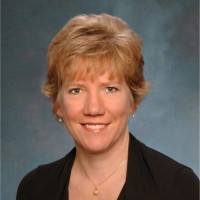
Happy summer, everyone! I am LaDonna DiCamillo, the Southern California Regional Director for the California High-Speed Rail Authority (Authority). As the weather heats up, so has progress in Southern California on the nation’s first high speed rail. Last newsletter I shared the details of the Authority’s partnership with LA Metro for the Link US project. The Authority is proud to contribute $423 million to a project that will transform LA Union Station into a modern mobility hub and help prepare Los Angeles for the 2028 Olympics.
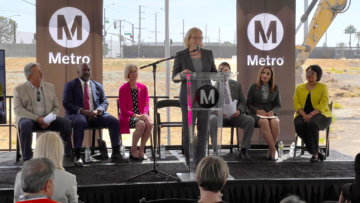 We’ve also seen movement on one of our other important projects in Southern California that will ready the region for high-speed rail service. The Rosecrans/Marquardt Grade Separation Project, broke ground this June. I was fortunate enough to attend the groundbreaking for this much needed project, one that will improve the safety of what the California Public Utilities Commission calls one of the most hazardous rail crossing in the state. From 2013-2019, there were 31 accidents involving vehicles and trains. 45,000 cars and 135 trains cross through this intersection on average each day. The Authority is a proud partner in this project, contributing $77 million to the total $156 million dollar grade separation that will improve congestion, air quality and safety. See more about the groundbreaking and my comments on this vital project.
We’ve also seen movement on one of our other important projects in Southern California that will ready the region for high-speed rail service. The Rosecrans/Marquardt Grade Separation Project, broke ground this June. I was fortunate enough to attend the groundbreaking for this much needed project, one that will improve the safety of what the California Public Utilities Commission calls one of the most hazardous rail crossing in the state. From 2013-2019, there were 31 accidents involving vehicles and trains. 45,000 cars and 135 trains cross through this intersection on average each day. The Authority is a proud partner in this project, contributing $77 million to the total $156 million dollar grade separation that will improve congestion, air quality and safety. See more about the groundbreaking and my comments on this vital project.
As summer turns into fall, we will build upon this groundbreaking by releasing the draft environmental materials for our Palmdale to Burbank project section. This segment will connect two key population centers in Los Angeles County with multimodal transportation hubs in Palmdale and Burbank and run approximately 31 to 38-miles long. The environmental materials will be made available on September 2 and will remain open for a minimum 60-day public comment period. This public comment period will allow stakeholders the chance to provide feedback on the document before the Authority produces a final environmental report. Click here to see more information on how to read and respond to Environmental Documents.
Thanks for staying tuned in to the progress high-speed rail is making statewide and in Southern California as we move closer to delivering the nation’s first high-speed rail.
More on Link Union Station
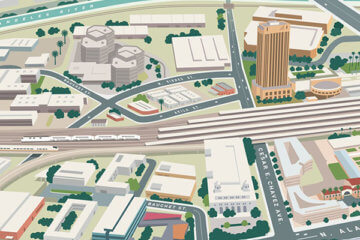 As mentioned above, the Authority approved a $423.335 million Project Management and Funding Agreement for the Link Union Station (Link US) Phase A project in April. Forecasted to open in 2028, this project will transform Los Angeles Union Station (LAUS) into a modern transit hub ready to host fans from all over the world for the 2028 Summer Olympics.
As mentioned above, the Authority approved a $423.335 million Project Management and Funding Agreement for the Link Union Station (Link US) Phase A project in April. Forecasted to open in 2028, this project will transform Los Angeles Union Station (LAUS) into a modern transit hub ready to host fans from all over the world for the 2028 Summer Olympics.
Metro’s Link US Phase A Project will provide better transit by improving connections between Metrolink, Metro Rail and bus services. It will create a new concourse with shorter wait times and an easier transfer experience. This project will also ready LAUS for the arrival of high-speed rail service.
In addition to these innovations, the Link US Phase A Project will create run through tracks over the 101 freeway, increasing capacity and saving time. Currently, trains come into LAUS from one direction, are unloaded, and then new passengers board before the train reverses towards the direction from which it came. Since a train arrives and departs on the same set of tracks, trains may cross paths and cut off all traffic to a station as a single train enters or leaves. With run through tracks, trains will come in from one direction, unload, board new passengers and continue in the same direction. Run through tracks avoid forcing trains to share limited track access in and out of the station. Once complete, the Link US Phase A Project will allow for faster train movements, higher capacity and increased safety.
The Link US Phase A project is just one example of the progress happening for high-speed rail in the Southern California region. This project is essential to preparing Los Angeles for future high-speed rail service and increasing mobility for people across the Southern California region.
Southern California Launches Small Business Outreach Program
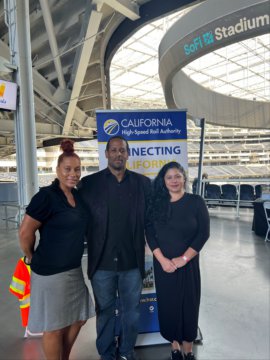 The Southern California Region has officially launched outreach activities for the California High-Speed Rail Authority’s (Authority) Small Business Program.
The Southern California Region has officially launched outreach activities for the California High-Speed Rail Authority’s (Authority) Small Business Program.
The excitement for high-speed rail is growing in Southern California and there is strong interest amongst small businesses to learn more about the project sections and how they can get involved. To meet demand, the Authority is focused on providing additional outreach efforts in the Southern California region. The goal is to expand existing statewide efforts with small businesses in Southern California.
The program’s objective is to create a Small Business Program that is flexible, attainable, efficient and credible. The Authority is committed to small businesses playing a major role in building the statewide high-speed rail project and has an aggressive 30% goal for small business participation including Disadvantaged Business Enterprises (DBE), Disabled Veteran Business Enterprises (DVBE) and Micro-Businesses (MB).
“Small businesses around the state play a major role in building the nation’s first high-speed rail. Although we are not currently in construction in Southern California, the Authority wants businesses to know that, no matter your location in the state, certified small businesses can apply for government contracts with the Authority,” said Southern California Regional Director LaDonna DiCamillo. “Our goal is to spread the word about the Authority’s Small Business Program to get businesses prepared and eager for future contracts.”
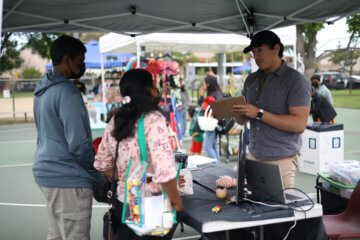 As of May 31, 2022, 721 certified small business are working on the high-speed rail project statewide and 233 small business are from Southern California. 229 are DBEs and 82 are DVBEs. Learn more about the Authority’s Small Business Program on the Authority’s website.
As of May 31, 2022, 721 certified small business are working on the high-speed rail project statewide and 233 small business are from Southern California. 229 are DBEs and 82 are DVBEs. Learn more about the Authority’s Small Business Program on the Authority’s website.
Hear how one Southern California business contributed to the high-speed rail project during the pandemic in an interview with Information Officer Crystal Royval and Conaway Geomatics Inc. The recently released summer edition of the Authority’s Small Business newsletter included two updates on outreach in Southern California. Check out the Authority’s participation the California Department of Transportation 2nd Annual DBE Summit at SoFi Stadium this summer, and learn more about the small business MBI Media that is assisting the Authority with outreach in the Palmdale to Burbank region in preparation for release of the draft document in September.
Frequently Asked Questions
Southern California high-speed rail staff respond to many inquiries from residents, local agencies, neighborhood groups and other stakeholders. Below are answers to some of the more common questions about the program.
What is a unique feature of the Palmdale to Burbank project section?
This project section will connect two key population centers in Los Angeles County with multimodal transportation hubs at the Palmdale Transportation Center Station and at the Hollywood Burbank Airport. These stations will provide vital links between the Antelope Valley, the Los Angeles Basin, California and the rest of the country through the eventual connection to the Hollywood Burbank Airport. Unique to this section, high-speed rail will travel underground through the Los Angeles National Forest and the San Gabriel Mountains National Monument to minimize environmental impacts to nearby wetlands.
Stay tuned and check out the next newsletter for more information about tunneling in the SoCal region and to learn more about the Palmdale to Burbank project section.
Have any questions for the SoCal team? Please submit them to us at southern.calfornia@hsr.ca.gov.
Quarterly Newsletter Archive
- Spring 2023 All Aboard Newsletter
- Winter 2023 Quarterly Newsletter
- Fall 2022 Quarterly Newsletter
- Summer 2022 Quarterly Newsletter
- Spring 2022 Quarterly Newsletter
- Winter 2022 Quarterly Newsletter
- Fall 2021 Quarterly Newsletter
- Summer 2021 Quarterly Newsletter
- Regional Newsletter - May 2021
- Regional Newsletter - February 2021
- Regional Newsletter - November 2020
- Regional Newsletter - August 2020
- Regional Newsletter - June 2020
- Regional Newsletter - February 2020
- Regional Newsletter - November 2019
- Regional Newsletter - August 2019
The California High-Speed Rail Authority makes every effort to ensure the website and its contents meet mandated ADA requirements as per the California State mandated Web Content Accessibility Guidelines 2.0 Level AA standard. If you are looking for a particular document not located on the California High-Speed Rail Authority website, you may make a request for the document under the Public Records Act through the Public Records Act page. If you have any questions about the website or its contents, please contact the Authority at info@hsr.ca.gov.



